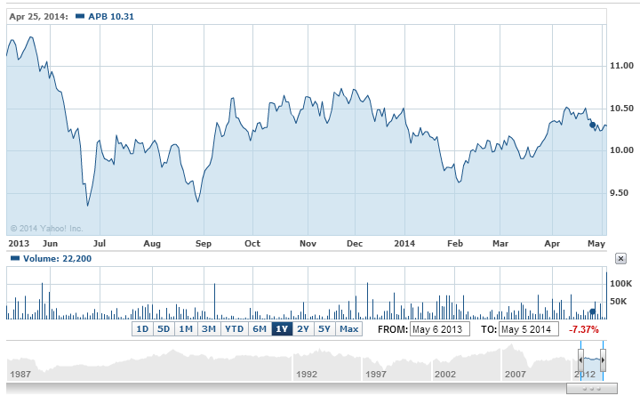Summary
- Elevated stock benchmarks make closed-end funds more attractive.
- Positive growth surprises in China support the outlook for emerging Asia.
- APB offers access to well-positioned companies that are difficult for US investors to buy directly.
For most of this year, some of the most commonly watched stock benchmarks have been trading at or near record territory. To some, this might have come as a surprise, given the fact that the Federal Reserve has made its policy intentions clear and suggested that its historic QE programs will likely be phased-out well before the end of 2014. But growth numbers on both the domestic and global levels have been supportive for risk appetite, and this should not be overlooked, as it means the underlying fundamental trends support the runs higher in assets like the SPDR S&P 500 Trust ETF (NYSEARCA:SPY), which tracks the performance of the world’s most important stock index.
Risk vs. Reward
All of this suggests that the multi-year bull run in stocks is warranted, and that there is no real cause for concern if you are long equities. But it also means that there is more downside risk than upside potential when we look at things from the broader perspective. In other words, potential rewards are limited and much larger downside risks could still be seen. One strategy for dealing with this type of climate is to use the closed-end fund (CEF), which will often trade at a discount to its net asset value (NAV), and create better opportunities to buy undervalued stocks. This investment approach offers some great advantages for those that might be looking to take some profits and move away from SPY at its higher levels.
Underlying Strength in Emerging Asia
Bargain-priced CEFs offer some interesting advantages in market climates like the one we are currently seeing, although choosing funds within this category adds another layer of difficulty. But there are certain arguments that can be made for those with exposure to emerging Asia, given the upside surprise we recently saw in Chinese GDP data. GDP growth in the world’s second largest economy grew by 7.4% in Q1, silencing many of the arguments weakness in export data would negatively influence other aspects of the economy. For a good portion of this year, markets have been bracing for the seemingly increased possibility that China would be facing a hard landing.
The latest data greatly reduces the chances for a sustained slowdown, and this creates a more supportive framework for assets like the iShares MSCI Emerging Markets Index ETF (NYSEARCA:EEM), which exposure to more than 800 large and mid-cap companies in the region. Key examples include China Mobile (NYSE:CHL), Tencent Holdings, and Samsung Electronics, all of which should benefits from the improved expectation for the region. But while there is nothing wrong with setting aside some portfolio space for an ETF like EEM, there are still better ways of gaining access to emerging Asia at a discount price.
The Asia-Pacific Fund
(Chart Source: Yahoo!)
One of the best choices here is the Asia-Pacific Fund (NYSE:APB), which offers a 10.8% discount to NAV and has been building in bullish momentum since the beginning of February. Holdings within the fund are well-diversified across both individual industry sectors and in geographical regions. Most of the fund is devoted to companies in the consumer discretionary, financial, and information technology categories and include names like Hyundai Motor, the Bank of China, and Skyworth Digital. APB’s stock price has stabilized from its September lows but there is still significant room to the topside as it trades near the bottom of its historical range.
Investment strategy within the fund focuses mostly on new developments in consumer demographic trends and its significant exposure to South Korea (26% of the fund) should benefit from rising export numbers in that country, as well. In March, exports rose by 5.2% as developed market demand for items like memory chips and cell phones beat analyst estimates. Taken together, all of these factors should lead to raised price targets for companies in these key markets, and APB offers access to stock selections in emerging Asia that are difficult for US investors to buy directly. On the whole, APB is a stable way to gain exposure to emerging Asia at a discount price, and should be viewed as a solid portfolio component given the elevated price levels that are seen in the broader stock benchmarks.


